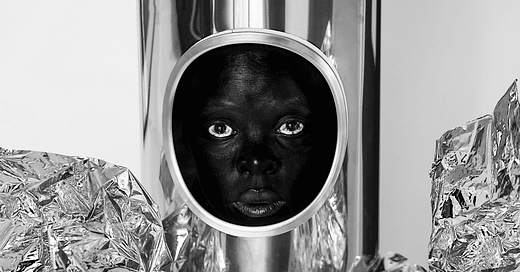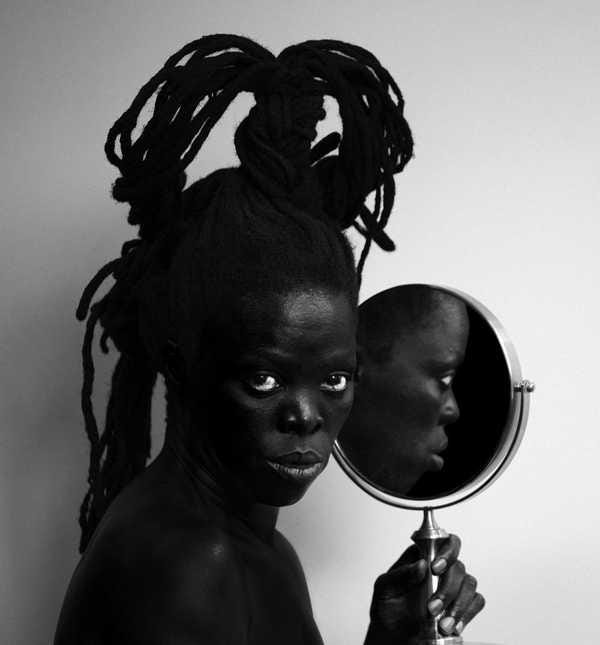“Multicultural empires often frame power as representational while simultaneously wielding power through surveillance. Multiculturalism, because it describes difference in terms of race, is also a theater game that is controlled by its orientation toward the white gaze because race is a vocabulary of being controlled by white power. Visibility as power, or race, reveals some things while hiding others. Race orients the world toward the white male gaze. As in Foucault’s panopticon, these gazes are lines of sight that are imagined to emanate from cultural centers of power but often control events when the surveillance towers are empty. Fanon ‘had to meet the white man’s eyes.’ Colonial subjects are trained by colonizers to see themselves through the eyes of the colonizer—as ‘nationals’ rather than ‘natives.’ These ‘nationals’ orient the former colonies to the West and toward modernity.” - Alice Sparkly, Postcolonial Astrology
Dear reader,
Have you gotten your REAL ID yet? In this mandated state visibility, purportedly aimed to “deter terrorism”, image and representation continue to restrict bodily autonomy across political borders. At the height of apartheid in South Africa, the government required “passbooks” to be carried by all black persons over the age of sixteen at all times, amid the countless racially-motivated, segregationist policies and laws to repress Black communities.
The Polaroid ID-2 camera, which had a 'boost' button to increase the strength of its flash—so that the user could better capture dark-skinned people—was the chosen technology for photographing black South Africans for dompas, as passbooks came to be known. This particular camera was instrumental to creating a South African black identity that was fixed, flat, stultified.
I’m interested in visual activists like Joan E Biren that push back against this repression, working to carve out space in visual culture and beyond for reclamation and archival preservation. The aesthetic is political—the colors, the lighting, the composition. A REAL ID or a passport or passbook are far from the royal portraiture of the powerful so what does it mean when we ( the historically abject, the queer, the black, the red and femme), find a reflection in royal representation? Is it not the evidence of internalized colonization, as explained by Alice Sparkly Kat above?
This question, and this convergence of history, aesthetics, and power are presented anytime a court card comes up, but more broadly with the omnipresent selfie of the digital age.
Tarot certainly presents a unique entry into visual culture that is the relation between what is visible and the names that we give to what is seen. And what we visualize, as with the aid of the cards, is not always visible. To unpack what it means to be a visual activist and the repressive social and political context from which this position and practice emerge, I am announcing the next iteration of Paper Crowns is open for enrollment.
We will center South African visual activist, Zanele Muholi, to codify the court cards so that when we read them we will see in their reflection evidence of existence, of being, of presence.
“I picked up the camera because there were no images of us that spoke to me at the time when I needed them the most. I had to produce a positive visual narrative of my community and create a new dialogue with images” - Zanele Muholi
At stake for visual culture is how to see the world, all the more pressing when the world is changing so dynamically while exponentially expanding just how much there is to see and oh so many different points of view. Red tarot reading engages visual culture as an active way to create change, more than just a means to visualize what is happening.
Thus Paper Crowns will explore the court cards as an archive of the portraits of the powerful. Within these compositions we will contend with the myriad ways one can face - and be faced with - our own subjectivity. We will concern the visibility of the historically invisible, the politics of the gaze, the construction of new archives; the tarot reader as visual activist generating new ideas about community and citizenry.
In looking at these images we will acknowledge and enrich our own impressions of agency and power. By expanding the regard portraiture affords, we will assert our status as significant. This reading of the court will not be not photography-as-death, of transforming subject into museum object, as Roland Barthes describes in Camera Lucida but its opposite.
Paper Crowns will make these royal portraits in the court cards come alive as a subjectification of the objectified. This course is a reclamation of the historically laden image for those who have come before. No prior experience with tarot required but always welcome.
June 26 - July 24 / 5 - week intensive, Sundays, 3pm pst / payment plans & low-income enrollment options available
COURSE SCHEDULE:
Week 0 - The Pose Pretends
Introductions are in order. We will meet face-to-face mediated via our screens and our cards. Each student will divine a court card to guide their studies. Before divining into each of the court cards we will look more broadly at the stories portraits tell: they are interpretations of their sitters, visual narratives for which we assume sitters and painters are, in varying degrees, responsible. The skilled reader, or art-historian, is understood to be able to assess the subjects inner nature by means of their external expression. But what of the fiction of the pose? How can adapting and complicating the drama of the scopic interaction shake off the death of inauthenticity so that as the sitter and seer of the portrait we may be roused to resist objectification.
Week 1 - The Royal Mirror & the Imperial Portrait
The Imperial Mirror is made to maintain le majeste of the king, and this mirror does not obey the laws of optics but the laws of absolutist power. White sight is incarnated in the figure of the “king” and attendant kingship. As we examine the portraits of kings and presidents through the mirror in the court cards we cross the visual bridge between past, present and future. This optically incorrect visualization will open a doorway for us to see ourselves, our clients in these royal reflections. We will see Sovereignty anew and break it apart from the white male body while we contemplate the postures of power.
Week 2: The Queen’s Oppositional Gaze
To be a woman in the world was/is to be the object of the male gaze. Giovanni Bocca writes that to 'appear in public' is 'to be looked upon.' Portraits of women maintain constructions of genders and are not natural, neutral images. So what happens when we see a woman seeing herself? And when she sees you seeing her, there is no escaping her gaze. To learn from the Queens of the Court we will hail the dark lioness, Zanele Muholi. With so many faces and so many phases we will see her powerful self-portraiture as proxy for each of the Queens, and we will emboldened in our right to look.
Week 3 : Look At That Horse
Black Cowboys, Cowgirls and Vaqueros will make sense of the chivalric knight. We will be tarot readers as riders and we’ll be buckin. Who is a hero and how does the horse entwine our consciousness in a ‘prostheses’ like tarot? With the knights we will undo the strictures of Cartesian dualism to reconcile thought with embodiment. Let us shift our perception toward the nonhuman to arm ourselves against the westward expansion working in perpetuity to colonize consciousness and country alike.
Week 4 - The Squire’s Selfie
The selfie is remaking the global self-portrait. It adopted the machine-made aesthetic of postmodernism and then adapted it for a global online audience. We will end with pages insisting upon their inscription upon the pages of the visual archive. Led by artists like Rotimi Fani-Kayode and activists like Bisan Owda, the Pages will affect future histories with their prescriptions for visual interventions. Students, like my stunning Kieuntha as the King of Cups above, will present their self-portraits leaving our court cards all the more curated for liberatory consciousness.
Ready to Confront the Crown?
Sign up to understand the court as emissaries of the elements and get versed in the postures of power.
x,
Christopher












I'm dying to take this one!! I was dying to take it last time but don't know if I can squeeze it in! AAAACK! I'm gonna see...